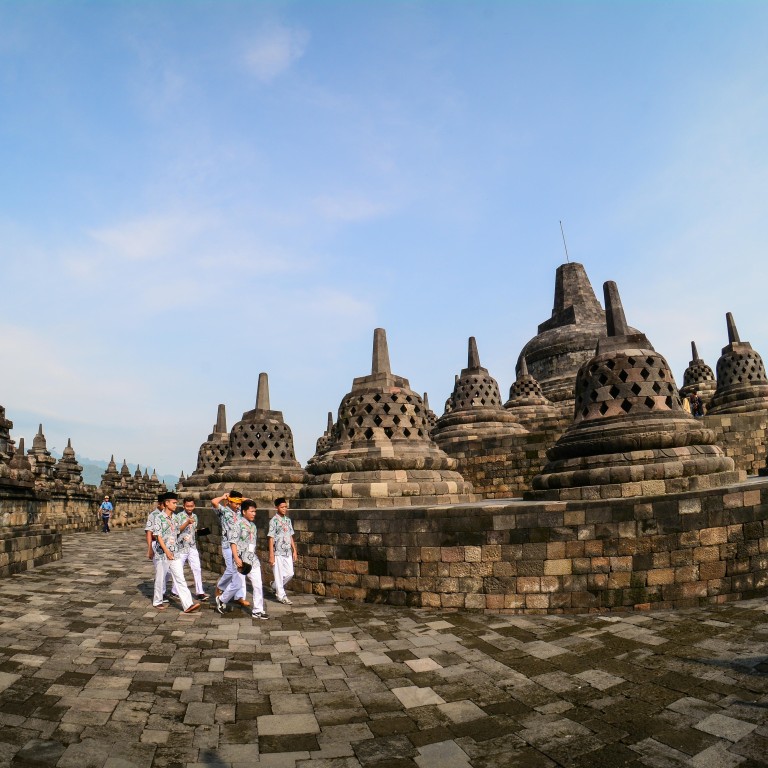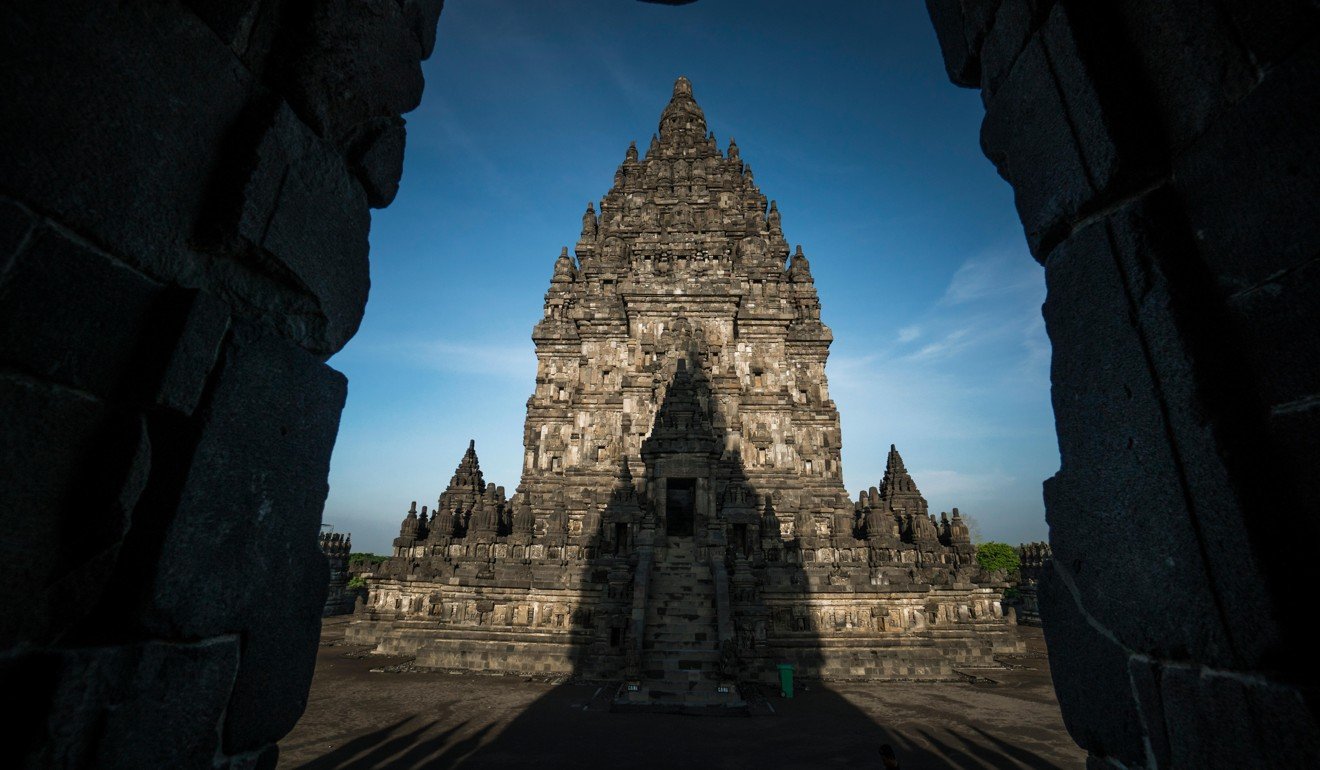
Borobudur and Prambanan: two Indonesian temples to rival Angkor Wat
- The two sites are among the world’s largest and most elaborate temple complexes, one Buddhist, one Hindu
- Located near Yogyakarta, on the island of Java, one is best viewed at sunrise, the other at sunset
In an era when everything has been not only “discovered” and written about, but also Instagrammed and emblazoned on a T-shirt, it’s hard not to feel a little envious of world travellers from days past. For me, this sentiment is rarely more acute than when weaving through the crowds at ancient temples and imagining how it must have felt to stumble on such sites in relative solitude.
They have been gradually restored to something approaching their former glories and granted Unesco World Heritage status. Today, they are two of Indonesia’s most visited attractions.

Each is best viewed at a different time – Borobudur at sunrise and Prambanan at sunset – which not only adds to the sense of symmetry but also makes it easy (although not necessarily advisable) to see both in one day. Like most visitors, I opt to start my explorations at Borobudur, first checking into a Rumah Dharma traditional cottage, set amid rice fields and within easy reach of the complex.
Having set my alarm for 3.45am, I cycle into the pre-dawn darkness to begin an ascent of the world’s largest Buddhist temple.
Standing 35 metres high on a 123-square-metre base (about the size of two football pitches), Borobudur is imposing even before you get close enough to see the myriad relief panels, life-size Buddha statues and perforated stupas that adorn it from top to bottom. Built from volcanic rock over about 75 years during the Shailendra dynasty, the pyramid-like temple has nine levels. These take pilgrims on a symbolic journey through the three levels of Buddhist cosmology, from the world of desire (Kamadhatu), through the world of forms (Rupadhatu) to the world of formlessness (Arupadhatu), the highest sphere of existence.
Whether you’re a believer or not, this means climbing a lot of steps. I experience a profound sense of relief when I reach the top and rest beside a large seated Buddha to await the sunrise with about 30 other bleary-eyed visitors. Having googled “Borobudur at sunrise”, I am primed for radiant purple, pink and orange skies bathing the giant, bell-shaped stupas in picture-perfect celestial light. But dawn brings a more muted otherworldly glow, with the sun struggling to break through the clouds and a thick blanket of mist shrouding the temple and the surrounding jungle.
A trio of tripod-sporting photographers appear disappointed but, to me, it seems strangely perfect, and I make use of the brightening morning to take a closer look at some of the temple’s architectural treasures. These include 2,672 incredibly detailed relief panels depicting stories from Buddhist scripture and Javanese folklore, and 504 Buddha statues, about half of which are missing their heads, which were looted and carted off to distant museums during the 19th century.
The relatively modest nearby temples of Pawon and Mendutalso deserve a visit. Believed to be slightly older than Borobudur, these holy structures are geographically aligned with their more famous neighbour, although the exact relationship between them remains unknown. Next to Mendut stands a spectacular bodhi tree that provides a shaded spot in which to sit and ponder this mystery.

The largest Hindu temple complex in Indonesia, and one of the largest in the world, Prambanan originally comprised 240 individual buildings, but almost all have been reduced to rubble by earthquakes over the past millennium. Thanks to decades of painstaking restoration work, however, the 16 main temple buildings have been reconstructed, giving visitors the chance to step back in time and imagine how awe-inspiring this site must have been in its prime.
Designed to represent Meru, the mountain home of the gods in Hinduism, Prambanan pays tribute to the trio of supreme deities, or the Trimurti – Brahma the creator, Vishnu the preserver and Shiva the destroyer – each of whom has their own temple sheltering a huge statue. The largest is dedicated to Shiva, standing a towering 47 metres high and sporting intricate bas-reliefs telling the epic Hindu poem of Ramayana, a fantastical tale of gods and demons, which is also enacted here in traditional dance during the dry season (May to October). An illuminated Prambanan makes a spectacular backdrop.
Although less than 10 per cent of Prambanan’s original layout remains, there are enough related sites in the vicinity to satisfy even the most ardent temple hoppers. It would be easy to spend a day or two exploring the area’s dozen or so religious complexes, from the ornate buildings and statues of the 8th-century Sewu compound to the hilltop Ijo complex, which dates to the 10th century.

Most worthy of attention, however, is another lofty site. Perched on a hill about 3km south of Prambanan, Ratu Boko was built towards the end of the 8th century, and may have been a fortified palace or a monastic retreat dedicated to meditation and contemplation, although no one knows for sure. The sprawling 16-hectare site has a variety of ruins to explore – among them the imposing main gate, which has been substantially restored – and offers panoramic views of the verdant surrounding area, which is pancake flat except for Prambanan’s distinctive silhouette and the volcanoes of Merapi and Merbabu in the distance.
Ratu Boko is a popular sunset spot, but I return to Prambanan as the sun begins its descent. The skies are wonderfully clear and, as the sun edges closer to the horizon, the temples start to turn a bright terracotta hue reminiscent of another awe-inspiring holy site, Australia’s Uluru (aka Ayers Rock).
Standing amid these towering, glowing structures as the heavens put on a show and reveal the temples in their full majesty, it’s possible to believe for the briefest of moments that this truly is the home of the gods.

